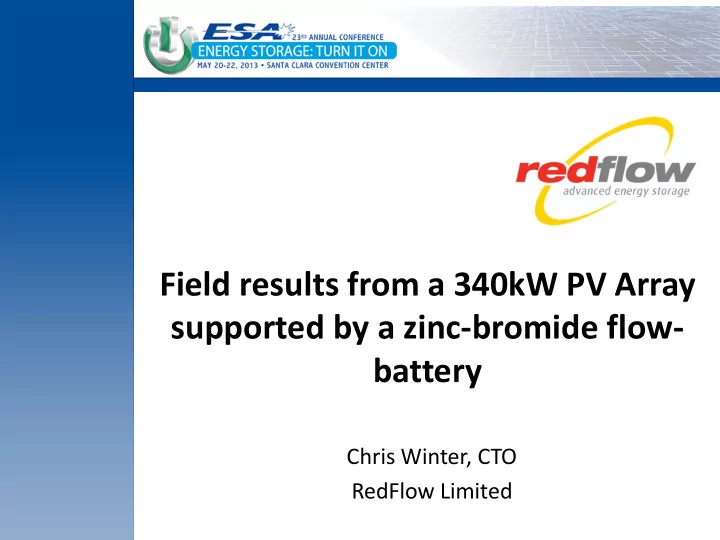

Field results from a 340kW PV Array supported by a zinc-bromide flow- battery Chris Winter, CTO RedFlow Limited
Field trial site – Brisbane, Australia • 340 kW roof-top mounted solar PV array supported by, • 90 kW / 240 kWh containerised zinc-bromine flow battery system • Operational since July 2012 340kW PV Array supported by RedFlow’s 90kW ESS 340kW Unsupported PV Array
Current challenges for Solar PV • PV Cost – This has been addressed as costs reach grid parity o Why? PV panels are mainly 20kg of low-cost components e.g. glass and aluminium • PV Intermittency – Is now an increasing issue o It lowers the value of solar PV, but is location dependent 2 intermittency issues: o Up to 15-20% PV – Weather-related stability issues on the grid o From 30-40% PV – Curtailment Issues because of too much generation at the wrong times • Energy Storage – represents one part of the solution for these intermittency issues by changing the shape of the PV output curve to more closely match the customers needs.
Option 1 – Begin day with empty flow battery • Charge throughout the day then discharge during peak period (attractive to utilities struggling with too much Solar PV) • Not ideal for most non-flow battery technologies (as they do not like to spend 14 hours per day at 0% SOC) 250 Start Day at Grid Output Power (kW) 200 0% SOC 146.90 kWh Sunny mid-winter 150 delivered by M90 day in Brisbane (Peak Period for 100 289.32 kWh University) consumed by M90 50 0 5:00 AM 6:00 AM 7:00 AM 8:00 AM 9:00 AM 10:00 AM 11:00 AM 12:00 PM 1:00 PM 2:00 PM 3:00 PM 4:00 PM 5:00 PM 6:00 PM 7:00 PM -50 PV Power (kW) M90 Adjusted PV Power (kW) System: 340kW PV and Charged at 185A 8:30am-2:30pm 90kW / 240kWh ESS Discharged to empty at 350A 2:30pm-5pm
PV is not always that cooperative • The results on an overcast day (below) highlights the need for real- time communications to optimise end-customer benefits. • This day began with an empty battery which charged from the PV and the grid and then discharged into the peak demand period. 250 Grid Output Power (kW) 200 150 100 50 0 -50 5:00 AM 7:00 AM 9:00 AM 11:00 AM 1:00 PM 3:00 PM 5:00 PM 7:00 PM PV Power (kW) M90 Adjusted PV Power (kW) System: 340kW PV and Charged at 185A 8:30am-2:30pm 90kW / 240kWh ESS Discharged to empty at 350A 2:30pm-5pm
Option 2 – Begin the day with half-full battery • Provide a guaranteed level of PV power during the day independent of the conditions (attractive in some applications) • Not ideal for many non-flow battery technologies (as they do not like to spend 14 hours per day at 0% SOC and the rest at partial SOC) 250 Start Day at 50kW constant Grid Output Power (kW) 200 70% SOC output Overcast mid- 150 winter day in ESS fully charged 100 Brisbane 50 0 -50 5:00 AM 6:00 AM 7:00 AM 8:00 AM 9:00 AM 10:00 AM 11:00 AM 12:00 PM 1:00 PM 2:00 PM 3:00 PM 4:00 PM 5:00 PM 6:00 PM 7:00 PM PV Power (kW) M90 Adjusted PV Power (kW) System: 340kW PV and Charge and discharge reacting 90kW / 240kWh ESS dynamically to solar output
Business case - How much energy storage? • There is no fixed ratio between the sizes of PV and energy storage, but it is application-, cost-, site- and scale-specific • The aim is to add as little energy storage as possible and still maximise the value of PV energy o Utilities e.g. peak reduction requires ~100% o Solar Supplier e.g. increased value of solar requires <100% o Off-grid e.g. no other back-up requires >100%
Business case – “System Integrator” strategy • Flow battery manufacturers partner with third-party System Integrator (SI) companies to build energy storage systems (ESS) around standard modular flow batteries. • Why? o Flow battery manufacturers are usually only experts in the battery part of an ESS (not PCS, controls etc.) o Easier to address international markets - 80% of regulations apply to the PE/PCS part of an ESS, which the SI already has. o Fortunately, due to the “uniqueness” of flow batteries, the market opportunities are growing as is interest from companies with System Integration capabilities and end-customer demand. o This business model needs “standard flow batteries” to integrate, as is the case with lithium-ion or lead-acid batteries.
M90 Zinc-bromide flow battery • Array of modular flow batteries used to build the energy storage system up to 240kWh maximum capacity • Uses standard 3 kW(cont.) / 8 kWh flow batteries connected in an array • M90 contains: o 24 flow batteries o 90kW PCS o Fan-based cooling o Remote control Zinc-bromide flow batteries operate from empty (0% SOC) – so it can shift more energy per kWh installed
How a zinc-bromide battery works • It is a zinc electroplating machine made out of plastic • It takes advantage of the high energy Zn-Br reaction and low-cost plastic manufacturing • Its cost potential is a function of the raw material cost – just like PV
Building Integrated flow battery • 120kW/300kWh flow battery system. • Roof-mounted 120kW PV array • Integration with Johnston Controls Building Management System • Commissioning in May 2013, Brisbane, Australia
Chris Winter, CTO RedFlow Limited
Recommend
More recommend